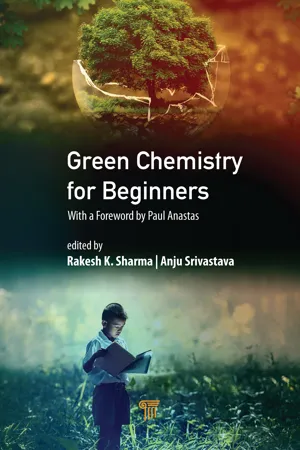Chapter 1
Genesis of Green Chemistry
Anju Srivastava,a Reena Jain,a Manavi Yadav,a,b and Rakesh K. Sharmab
aDepartment of Chemistry, Hindu College, University of Delhi, Delhi 110007, India
bGreen Chemistry Network Centre, Department of Chemistry, University of Delhi, Delhi 110007, India[email protected] We do not inherit the earth from our fathers, we are borrowing it from our children.
—David Brower
1.1 Introduction
The past few decades of the twentieth century saw chemistry contributing significantly to the advancement of human civilization. Chemists, with their magical powers to play with the chemical molecule, have been looked at as the problem solvers of the society. They have synthesized crop-enhancing chemical fertilizers and pesticides that enhance crop yields to ensure a constant and sustainable food supply. Modern medicines, health-care products, advanced diagnostic chemical tests, and analysis have played a key role in the eradication of hard-hitting diseases and infections, increasing the average life of humans from 45 to 75 years [1]. The innovative products arising out of research in chemistry and its interplay with other disciplines have led to cutting-edge advancements and commercially viable applications in numerous fields—transportation, computing, aerospace, electronics, and more. This contribution in specialty applications is over and above the role chemistry plays in our everyday lives by providing consumer products, such as our local grocery, hardware, detergents, clothes, plastics, adhesives, lubricants, paints, coatings, and even fire retardants.
Undeniably, therefore, without the continuous efforts of chemists and the enormous productivity of the chemical industries, the high standards of modern society could not have been attained. And in these enhancements, the environment has been used as a source of natural resources that can be exploited for the society by the scientific tool called chemistry. However, the rapid pace of development and application of chemical sciences has come at a heavy price, where the misuse of the otherwise fascinating science has led to the release of pollutants and toxic substances into land, air, and water and the production of nonbiodegradable materials, resulting in a harmful impact on the environment and living beings.
The scientific development of and research on molecules and products, until quite recently, was being done with a focus only on the desired molecules or products, with a very superficial understanding of the fate and toxicity of the chemicals in the environment. Obviously, there was no awareness and intent among scientists and policy makers to study any deleterious large-scale or global impacts of the development of new molecules and chemicals on the environment and health. In most cases, therefore, the negative and destructive impacts of chemicals were realized only when they had reached alarmingly high levels. Numerous examples can be discussed to support this fact.
In fact, even the environment problems for which chemicals have a negative public image can be mitigated with long-term sustainable solutions using the knowledge of chemistry. As is often said, chemical problems require chemical solutions.
In the subsequent sections, the reader will be taken through the various infamous disasters affecting the environment and life that have over time led to the emergence of green chemistry and its philosophy.
1.2 Early History
In the 1940s, the chlorine-based hydrocarbon dichlorodiphenyl-trichloroethane (DDT) was developed as a pesticide and was found to be very effective in eradicating not only pests but also the vectors causing diseases like malaria and yellow fever. This proved to be an elixir for both the agriculture and health sectors and distinguished itself during World War II, clearing malaria-causing insects for US troops. The indiscriminate use of DDT proliferated, until in 1962, Rachel Carson, a marine biologist and writer, courageously published her book Silent Spring, which exposed the hazards of the pesticides manufactured by chemical industries. The book described how these chlorine-containing compounds entered the food chain and bioaccumulated to pose as a threat to the survival and existence of several species of birds and other living beings. Silent Spring helped in the launch of a new public awareness that nature was vulnerable to human intervention. Ten years after the book’s publication, the government banned the use of this pesticide [2, 3].
Around the same time, in Europe, pharmaceutical companies were selling a newly synthesized thalidomide-based drug for treating morning sickness and nausea in pregnant women. While the medicine proved to be very effective and brought a wave of joy among the expecting mothers, the children born to these mothers were found to have acute birth defects with deformed or missing limbs. These thalidomide babies were born because the drug had its enantiomers acting as a teratogen, which was being synthesized inadvertently along with the actual drug. The infamous incident caused the birth of 10,000 such deformed babies worldwide, with as many as 5000 such babies in Germany alone. The drug was immediately banned from use and was removed from all the pharmacists’ outlets [4].
Invented in the 1930s, chlorofluorocarbons (CFCs), popularly called freons, were considered a class of wonder hydrocarbons that, due to their low toxicity and nonreactive nature, found numerous industrial and consumer applications, including as refrigerants, propellants, hospital sterilant, industrial solvents, and foam-blowing agents. Their worldwide market increased multifold in a very short span of time. After about 40 years of indiscriminate use of these so-called benign compounds, it was found in 1974 that these compounds, when released into the atmosphere, diffuse to the stratosphere, where their chlorine component depletes and destroys the ozone layer, which acts as a protective shield against the harmful ultraviolet radiations, which otherwise are dangerous for life on this planet. When a definite link was established for this observed relation, CFCs were banned in 1987 under the Montreal Protocol [5].
In the early 1970s, an oil slick and debris within the Cuyahoga River caught fire in Cleveland, Ohio, US, drawing national attention to the environmental problems in the United States. This was not the first time that the river had caught fire. Fires had occurred on the Cuyahoga River several times earlier also. In fact, one such fire in 1952 caused damage worth over US$1.5 m...
